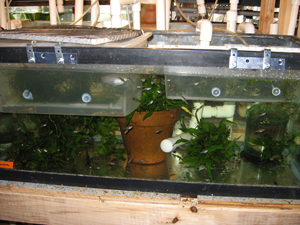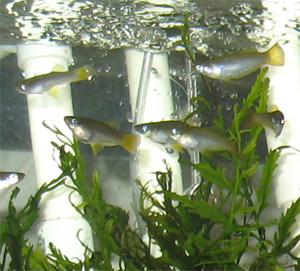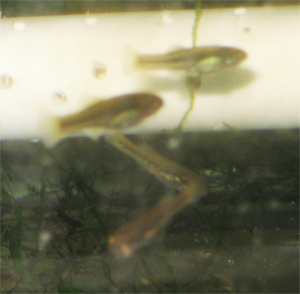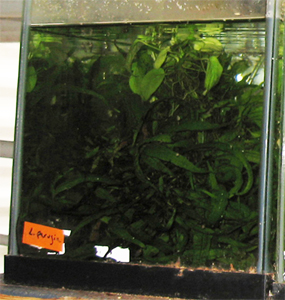 |
A lack of a consistent, effective means
to capture, save and raise up fry is likely the single reason fishkeepers
see declines in
numbers and eventually lose populations. Many batches of fry
often seem to disappear without an
established process
for collecting them.
There is an assumption that the larger fry of many livebearers,
when compared to the small fry of egg layers, makes
them easier to collect
and raise. In fact, most livebearers will eat their own fry-
which can make rescuing fry difficult,
and impossible with some
species unless a specific effort is made to save them.
When minimally fed or
stressed, all fish will eat their fry if they are large enough,
and the fry are small enough. With
frequent, quality
feedings, fry predation the first few days can be kept to a
minimum- after that the fry that manage to
survive become skilled
enough to avoid being eaten. The problem is that with some
species fry rarely survive, and all
too often one or two fry are
left of an initial group of 30 or 40. Worse, if you are breeding
for a particular trait, the
characteristics that
allowed those two fish to survive may not be the traits you are
breeding for.
Raising every fry is the
only way to select for the healthiest, most robust fish. Many
species left to community breed
within a small
population, over time, will take on undesirable characteristics
that reflect life in a confined space,
such as smaller size from
early maturing males taking advantage of their earlier
opportunities to breed.
Some species are less
prone to eating their young than others. Many lines of guppies
have been selectively bred not to
bother their young. The
two swordtails X. montezumae and X. mayae are also not
enthusiastic about eating their young,
particularly when well
fed. In contrast, most species within the genus’ Gambusia and
Brachyrhaphis will eagerly eat their
fry.
Most goodeids should be
assumed to eat their fry, though females having their first
batches, when they are still smaller,
will generally leave them
alone. Being larger, goodeid fry are far hardier when first
born, but species such as Z. tequila
still manage to eat them
anyway.
Most fish have a set
gestation period- for poeciliids it is generally about 30 days,
depending on temperature, and for
goodeids it is about 60
days. Sizes of broods vary by species, but number, health and
size of the broods can be increased
by moving the female to a
tank of her own when she appears gravid, and feed her well. Earthworms or
earthworm flake
seems to
be the best food for this.
Female poeciliids-
swords, guppies, mollies, platies, limias can store sperm, such
that a single fertilization can generate
as many as 8
successive broods. Goodeids breed fertilization to
fertilization.
The goal is to separate
the adult female from her young as soon as possible after they
are born, and for the young to be
born away from any other
larger fish. And there are a variety of ways to do this, without
putting the female through the
stress of being confined
to a small breeder, hung in the tank.
Most livebearers will
have their young between sunup and noon, though giving birth at
other times of the day is not
uncommon. The basic rule
is that if you see a single fry, chances are the entire batch
has been born, or the female
is in mid birthing- and
will be done in 20 minutes or so. The mother should then be
removed and put back into her
home tank. (Though a few
days to recover, where the female is not being chased around, is
always best if the space
is available.)
The young then need to be
kept in an environment conducive to their survival- as clean as
possible, but still
surrounded by quality
food at least twice per day, and when in a 5 gallon or smaller
container, a 50% water change
daily, the first few
days, is essential.
All females are pulled to have their fry separate from the other
adults, with the exception of the Ameca splendens,
where gravid females are
allowed to have their fry in their species tank, where they are
netted out to be raised
separately- they do not
seem to bother their young. All fry are
saved here using one of 3 methods:
|
 |



